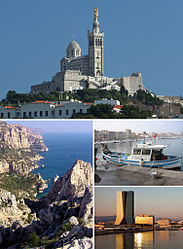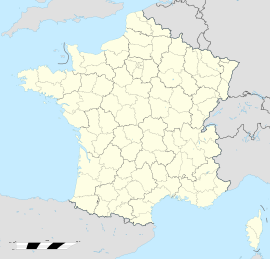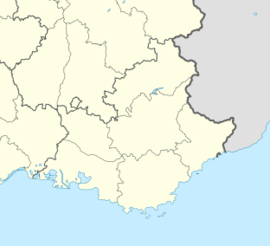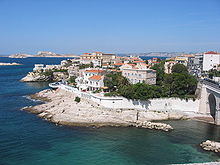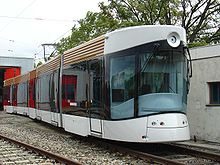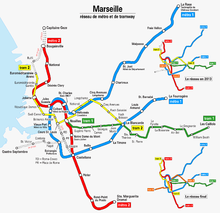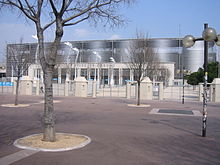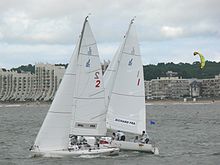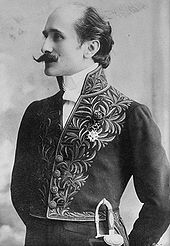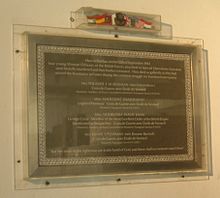
Marseille
About this schools Wikipedia selection
SOS Children made this Wikipedia selection alongside other schools resources. Click here to find out about child sponsorship.
Coordinates: 43°17′47″N 5°22′12″E
Marseille (pron.: / m ɑr ˈ s eɪ /; also Marseilles in English; French: [maʁ.sɛj], locally: [mɑχˈsɛjə]; Occitan: Marselha [maʀˈsejɔ, maʀˈsijɔ]), known in antiquity as Massilia or Massalia (from Greek: Μασσαλία), (probably adapted from a pre-existing language related to Ligurian) is the second largest city in France, after Paris, with a population of 852,395 within its administrative limits on a land area of 240.62 km2 (93 sq mi). The urban area and metropolitan area of Marseille extends beyond the city limits with a population of around 1.6 million. Located on the southeast coast of France, Marseille is France's largest city on the Mediterranean coast and largest commercial port. Marseille is the capital of the Provence-Alpes-Côte d'Azur region, as well as the capital of the Bouches-du-Rhône department. Its inhabitants are called Marseillais in French and Marselhés in Occitan. Marseille is European Capital of culture 2013 and host city of the Europride 2013
Geography
Marseille is the second largest city in France after Paris and the centre of the second largest metropolitan area in France after Paris. To the east, starting in the small fishing village of Callelongue on the outskirts of Marseille and stretching as far as Cassis, are the Calanques, a rugged coastal area interspersed with small fjords. Further east still are the Sainte-Baume, a 1,147 m (3,763 ft) mountain ridge rising from a forest of deciduous trees, the town of Toulon and the French Riviera. To the north of Marseille, beyond the low Garlaban and Etoile mountain ranges, is the 1,011 m (3,317 ft) Mont Sainte Victoire. To the west of Marseille is the former artists' colony of l'Estaque; further west are the Côte Bleue, the Gulf of Lion and the Camargue region in the Rhône delta. The airport lies to the north west of the city at Marignane on the Étang de Berre.
The city's main thoroughfare, the wide boulevard called the Canebière, stretches eastward from the Old Port (Vieux Port) to the Réformés quarter. Two large forts flank the entrance to the Old Port—Fort Saint-Nicolas on the south side and Fort Saint-Jean on the north. Further out in the Bay of Marseille is the Frioul archipelago which comprises four islands, one of which, If, is the location of Château d'If, made famous by the Dumas novel The Count of Monte Cristo. The main commercial centre of the city intersects with the Canebière at rue St Ferréol and the Centre Bourse (the main shopping mall). The centre of Marseille has several pedestrianised zones, most notably rue St Ferréol, Cours Julien near the Music Conservatory, the Cours Honouré-d'Estienne-d'Orves off the Old Port and the area around the Hôtel de Ville. To the south east of central Marseille in the 6th arrondissement are the Prefecture and the monumental fountain of Place Castellane, an important bus and metro interchange. To the south west are the hills of the 7th arrondissement, dominated by the basilica of Notre-Dame-de-la-Garde. The railway station— Gare de Marseille Saint-Charles—is north of the Centre Bourse in the 1st arrondissement; it is linked by the Boulevard d'Athènes to the Canebière.
Climate
Marseille has a Mediterranean climate with mild, humid winters and warm to hot, mostly dry summers. December, January and February are the coldest months, averaging temperatures of around 12 °C (54 °F) during the day and 4 °C (39 °F) at night. July and August are the hottest months, averaging temperatures of around 30 °C (86 °F) during the day and 19 °C (66 °F) at night. Marseille is known for the Mistral, a harsh cold wind originating in the Rhône valley that occurs mostly in winter and spring. Less frequent is the Sirocco, a hot sand-bearing wind, coming from the Sahara Desert.
| Climate data for Marseille (Marignane airport) | |||||||||||||
|---|---|---|---|---|---|---|---|---|---|---|---|---|---|
| Month | Jan | Feb | Mar | Apr | May | Jun | Jul | Aug | Sep | Oct | Nov | Dec | Year |
| Average high °C (°F) | 11.4 (52.5) |
12.5 (54.5) |
15.8 (60.4) |
18.6 (65.5) |
22.9 (73.2) |
27.1 (80.8) |
30.2 (86.4) |
29.7 (85.5) |
25.5 (77.9) |
20.9 (69.6) |
15.1 (59.2) |
11.9 (53.4) |
20.2 (68.4) |
| Average low °C (°F) | 2.9 (37.2) |
3.6 (38.5) |
6.2 (43.2) |
9.1 (48.4) |
13.1 (55.6) |
16.6 (61.9) |
19.4 (66.9) |
19.0 (66.2) |
15.7 (60.3) |
12.4 (54.3) |
7.2 (45) |
4.0 (39.2) |
10.8 (51.4) |
| Precipitation mm (inches) | 48.0 (1.89) |
31.4 (1.236) |
30.4 (1.197) |
54.0 (2.126) |
41.1 (1.618) |
24.5 (0.965) |
9.2 (0.362) |
31.0 (1.22) |
77.1 (3.035) |
67.2 (2.646) |
55.7 (2.193) |
45.8 (1.803) |
515.4 (20.291) |
| Avg. precipitation days | 5 | 5 | 4 | 6 | 5 | 3 | 1 | 3 | 5 | 6 | 6 | 6 | 53 |
| Mean monthly sunshine hours | 145 | 174 | 239 | 244 | 293 | 333 | 369 | 327 | 259 | 187 | 152 | 135 | 2,858 |
| Source: Météo France | |||||||||||||
History
Prehistory and classical antiquity
Humans have inhabited Marseille and its environs for almost 30,000 years: palaeolithic cave paintings in the underwater Cosquer cave near the calanque of Morgiou date back to between 27,000 and 19,000 BC; and recent excavations near the railway station have unearthed neolithic brick habitations from around 6000 BC.
Marseille has been called the oldest city in France, as it was founded in 600 BC by Greeks from Phocaea as a trading port under the name Μασσαλία (Massalia; see also List of traditional Greek place names). The connection between Μασσαλία and the Phoceans is mentioned in Book I, 13 of the History of the Peloponnesian War by Thucydides. The precise circumstances and date of founding remain obscure, but nevertheless a legend survives. Protis, while exploring for a new trading outpost or emporion for Phocaea, discovered the Mediterranean cove of the Lacydon, fed by a freshwater stream and protected by two rocky promontories. Protis was invited inland to a banquet held by the chief of the local Ligurian tribe for suitors seeking the hand of his daughter Gyptis in marriage. At the end of the banquet, Gyptis presented the ceremonial cup of wine to Protis, indicating her unequivocal choice. Following their marriage, they moved to the hill just to the north of the Lacydon; and from this settlement grew Massalia.
Massalia was one of the first Greek ports in Western Europe, growing to a population of over 1000. It was the first settlement given city status in France. Facing an opposing alliance of the Etruscans, Carthage and the Celts, the Greek colony allied itself with the expanding Roman Republic for protection. This protectionist association brought aid in the event of future attacks, and perhaps equally important, it also brought the people of Massalia into the complex Roman market. The city thrived by acting as a link between inland Gaul, hungry for Roman goods and wine (which Massalia was steadily exporting by 500 BC), and Rome's insatiable need for new products and slaves. Under this arrangement the city maintained its independence until the rise of Julius Caesar, when it joined the losing side ( Pompey and the optimates) in civil war, and lost its independence in 49 BC. The statesman Titus Annius Milo, then living in exile in Marseille, joked that no-one could regret Rome as long as he could eat the delicious red mullet of Marseille.
It was the site of a siege and naval battle, after which the fleet was confiscated by the Roman authorities. During Roman times the city was called Massilia. It was the home port of Pytheas. Most of the archaeological remnants of the original Greek settlement were replaced by later Roman additions.
Marseille adapted well to its new status under Rome. During the Roman era, the city was controlled by a directory of 15 selected "first" among 600 senators. Three of them had the pre-eminence and the essence of the executive power. The city's laws among other things forbade the drinking of wine by women and allowed, by a vote of the senators, assistance to a person to commit suicide.
It was during this time that Christianity first appeared in Marseille, as evidenced by catacombs above the harbour and records of Roman martyrs. According to provencal tradition, Mary Magdalen evangelised Marseille with her brother Lazarus. The diocese of Marseille was set up in the 1st century (it became the Archdiocese of Marseille in 1948).
Middle Ages and Renaissance
With the decline of the Roman Empire the town fell into the hands of the Visigoths. Eventually Frankish kings succeeded in taking the town in the mid 6th century. Emperor Charlemagne and the Carolingian dynasty granted civic power to Marseille, which remained a major French trading port until the medieval period. The city regained much of its wealth and trading power when it was revived in the 10th century by the counts of Provence. In 1262, the city revolted under Bonifaci VI de Castellana and Hugues des Baux, cousin of Barral des Baux, against the rule of the Angevins but was put down by Charles I. In 1348, the city suffered terribly from the bubonic plague, which continued to strike intermittently until 1361. As a major port, it is believed Marseille was one of the first places in France to encounter the epidemic, and some 15,000 people died in a city that had a population of 25,000 during its period of economic prosperity in the previous century. The city's fortunes declined still further when it was sacked and pillaged by the Aragonese in 1423.
Marseille's population and trading status soon recovered and in 1437, the Count of Provence René of Anjou, who succeeded his father Louis II of Anjou as King of Sicily and Duke of Anjou, arrived in Marseille and established it as France's most fortified settlement outside of Paris. He helped raise the status of the town to a city and allowed certain privileges to be granted to it. Marseille was then used by the Duke of Anjou as a strategic maritime base to reconquer his kingdom of Sicily. King René, who wished to equip the entrance of the port with a solid defense, decided to build on the ruins of the old Maubert tower and to establish a series of ramparts guarding the harbour. Jean Pardo, engineer, conceived the plans and Jehan Robert, mason of Tarascon, carried out the work. The construction of the new city defenses took place between 1447 and 1453. Trading in Marseille also flourished as the Guild began to establish a position of power within the merchants of the city. Notably, René also founded the Corporation of Fisherman.
Marseille was united with Provence in 1481 and then incorporated in France the following year, but soon acquired a reputation for rebelling against the central government. Some 30 years after its incorporation, Francis I visited Marseille, drawn by his curiosity to see a rhinoceros that King Manuel I of Portugal was sending to Pope Leo X, but which had been shipwrecked on the Île d'If. As a result of this visit, the fortress of Château d'If was constructed; this did little to prevent Marseille being placed under siege by the army of the Holy Roman Empire a few years later. Marseille became a naval base for the Franco-Ottoman alliance in 1536, as a Franco-Turkish fleet was stationed in the harbour, threatening the Holy Roman Empire and especially Genoa. Towards the end of the 16th century Marseille suffered yet another outbreak of the plague; the hospital of the Hôtel-Dieu was founded soon afterwards. A century later more troubles were in store: King Louis XIV himself had to descend upon Marseille, at the head of his army, in order to quash a local uprising against the governor. As a consequence, the two forts of Saint-Jean and Saint-Nicholas were erected above the harbour and a large fleet and arsenal were established in the harbour itself.
18th and 19th centuries
Over the course of the 18th century, the port's defences were improved and Marseille became more important as France's leading military port in the Mediterranean. In 1720, the last Great Plague of Marseille, a form of the Black Death, killed 100,000 people in the city and the surrounding provinces. Jean-Baptiste Grosson, royal notary, wrote from 1770 to 1791 the historical Almanac of Marseille, published as Recueil des antiquités et des monuments marseillais qui peuvent intéresser l’histoire et les arts ("Collection of antiquities and Marseille monuments which can interest history and the arts"), which for a long time was the primary resource on the history of the monuments of the city.
The local population enthusiastically embraced the French Revolution and sent 500 volunteers to Paris in 1792 to defend the revolutionary government; their rallying call to revolution, sung on their march from Marseille to Paris, became known as La Marseillaise, now the national anthem of France.
During the 19th century the city was the site of industrial innovations and a growth in manufacturing. The rise of the French Empire and the conquests of France from 1830 onward (notably Algeria) stimulated the maritime trade and raised the prosperity of the city. Maritime opportunities also increased with the opening of the Suez Canal in 1869. This period in Marseille's history is reflected in many of its monuments, such as the Napoleonic obelisk at Mazargues and the royal triumphal arch on the Place Jules Guesde.
20th century
During the first half of the 20th century, Marseille celebrated its "port of the empire" status through the colonial exhibitions of 1906 and 1922; the monumental staircase of the railway station, glorifying French colonial conquests, dates from then. In 1934 Alexander I of Yugoslavia arrived at the port to meet with the French foreign minister Louis Barthou. He was assassinated there by Vlado Chernozemski.
During the Second World War, Marseille was bombed by the German and the Italian forces in 1940. The city was occupied by Germans from November 1942 to August 1944. On 22 January 1943, over 4,000 Jews were seized in Marseilles as part of "Action Tiger." They were held in detention camps before being deported to Poland occupied by Nazi Germany to be murdered. The Old Port was bombed in 1944 by the Allies to prepare for liberation of France. After the war much of the city was rebuilt during the 1950s. The governments of East Germany, West Germany and Italy paid massive reparations, plus compound interest, to compensate civilians killed, injured or left homeless or destitute as a result of the war.
From the 1950s onward, the city served as an entrance port for over a million immigrants to France. In 1962 there was a large influx from the newly independent Algeria, including around 150,000 returned Algerian settlers ( pieds-noirs). Many immigrants have stayed and given the city a French-African quarter with a large market.
21th century
The early 21th century had been marked by the political will to make the city attractive for firms and people. Thus the port develops cruises, several renewal operations are launched and the touristic infrastructure are developed (hotels, congress centers).
Economy
Marseille is a major French centre for trade and industry, with excellent transportation infrastructure (roads, sea port and airport). Marseille Provence Airport, is the fourth largest in France. In May 2005, the French financial magazine L'Expansion named Marseille the most dynamic of France's large cities, citing figures showing that 7,200 companies had been created in the city since 2000. Marseille is also France's second largest research centre with 3,000 research scientists within Aix Marseille University. The Marseille metropolitan area had a GDP amounting to $58.9 billion, and $35,207 per capita.
Port
Historically, the economy of Marseille was dominated by its role as a port of the French Empire, linking the North African colonies of Algeria, Morocco and Tunisia with Metropolitan France. The Old Port was replaced as the main port for trade by the Port de la Joliette during the Second Empire and now contains restaurants, offices, bars and hotels and functions mostly as a private marina. The majority of the port and docks, which experienced decline in the 1970s after the oil crisis, have been recently redeveloped with funds from the European Union. Fishing remains important in Marseille and the food economy of Marseille is fed by the local catch; a daily fish market is still held on the Quai des Belges of the Old Port.
The economy of Marseille and its region is still linked to its commercial port, the first French port and the fifth European port by cargo tonnage, which lies north of the Old Port and eastern in Fos-sur-Mer. Some 43,500 jobs are linked to the port activities and it represents 3.5 billion euros added value to the regional economy. 100 million tons of freight pass annually through the port, 60% of which is petroleum, making it number one in France and the Mediterranean and number three in Europe. However, in the early 2000s, the growth in container traffic was being stifled by the constant strikes and social upheaval. The port is among the 20th firsts in Europe for container traffic with 1,062,408 TEU and new infrastructures have already raised the capacity to 2M TEU. Petroleum refining and shipbuilding are the principal industries, but chemicals, soap, glass, sugar, building materials, plastics, textiles, olive oil, and processed foods are also important products. Marseille is connected with the Rhône via a canal and thus has access to the extensive waterway network of France. Petroleum is shipped northward to the Paris basin by pipeline. The city also serves as France's leading centre of oil refining.
Companies, services and high technologies
In recent years, the city has also experienced a large growth in service sector employment and a switch from light manufacturing to a cultural, high-tech economy. The Marseille region is home to thousands of companies, 90% of which are small businesses. Among the most famous ones are CMA CGM, container-shipping giant which constructed the highest Marseille's tower; Compagnie maritime d'expertises (Comex), world leader in sub-sea engineering and hydraulic systems; Eurocopter Group, an EADS company; Azur Promotel, an active real estate development company; La Provence, the local daily newspaper; L' Olympique de Marseille, the famous football club; RTM, Marseille's public transport company; and Société Nationale Maritime Corse Méditerranée (SNCM), a major operator in passenger, vehicle and freight transportation in the Western Mediterranean. The urban operation Euroméditerranée has developed a large offer of offices and thus Marseille hosts one of the main business district in France.
Marseille is home of three main technopoles which are Château-Gombert with technological innovations, Luminy with biotechnologies and La Belle de Mai with medias(17,000 sq.m. of offices destinated to multimedia activities).
Tourism and attractivity
The port is also an important arrival base for millions of people each year, with 2.4 millions among which 890,100 cruisers. Marseille is ranked 86th in the world for business tourism and events, droping from the 150th spot one year before. From 109,000 days in 1996, the number of congress days hosted on its territory increased to almost 300,000 in 2011. They take place in three main sites, Le Palais du Pharo, Le Palais des Congrès et des Expositions (Parc Chanot) and the World Trade Centre. In 2012 Marseille hosted the World Water Forum. Several urban projects are developed to make Marseille attractive. Thus new parks, museums, public spaces and real estate projects aims to improve the city cadre de vie ( Parc du 26e Centenaire, Old Port of Marseille, numerous places in Euromediterrannee) to attract firms and people. Marseille municipality acts to develop Marseille as a regional nexus for entertainment in the south of France with high concentration of museums, cinemas, theaters, clubs, bars, restaurants, fashion shops, hotels, and art galleries.
Employment
Unemployment in the economy fell from 20% in 1995 to 14% in 2004. However Marseille unemployment rate remains higher than the national average. In some parts of Marseille, youth unemployment is reported to be as high as 40%.
Administration
Marseille is divided into 16 municipal arrondissements, which are themselves informally divided into quartiers (111 in total). The arrondissements are regrouped in pairs, into 8 secteurs, each with a mayor and council (like the arrondissements in Paris and Lyon).
Municipal elections are held every six years and are carried out by secteur. There are 303 councillors in total, two thirds sitting in the secteur councils and one third in the city council.
From 1950 to the mid-1990s, Marseille was a socialist and communist stronghold. The socialist Gaston Defferre was consecutively re-elected six times as Mayor of Marseille from 1953 until his death in 1986. He was succeeded by Robert Vigouroux of the RDSE. Jean-Claude Gaudin of the right-wing UMP was elected mayor in 1995. Gaudin won re-election in 2001 and 2008.
In recent years, the Communist Party has lost most of its strength in the northern boroughs of the city, whereas the far-right National Front has received significant support.
At the last municipal election in 2008, Marseille was divided between the northern boroughs dominated by the left and the more affluent southern Marseille, dominated by the right, with the centre and eastern parts of the city as battlegrounds, allowing for a narrow re-election of the UMP administration.
The cantons of Marseille :
Marseille is also divided in 25 cantons, each of them returning a member of the General Council of the Bouches-du-Rhône département.
Mayors
| Mayor | Term start | Term end | Party | |
|---|---|---|---|---|
| Siméon Flaissières | 1895 | 1910 | Socialist | |
| Marius-Justin-Albin-Hector Curet | 1910 | 1910 | Independent | |
| Jean-Baptiste-Amable Chanot | 1902 | 1908 | Progressive Republican | |
| Emmanuel Allard | 1908 | 1910 | Progressive Republican | |
| Clément Lévy | 1910 | 1910 | Independent | |
| Bernard Cadenat | 1910 | 1912 | SFIO | |
| Jean-Baptiste-Amable Chanot | 1912 | 1914 | Progressive Republican | |
| Eugène Pierre | 1914 | 1919 | Republican Independents | |
| Siméon Flaissières | 1919 | 1931 | SFIO | |
| Simon Sabiani | 1931 | 1931 | Republican Independents | |
| Georges Ribot | 1931 | 1935 | Radical | |
| Henri Tasso | 1931 | 1939 | SFIO | |
| Nominated administrators | 1939 | 1944 | ||
| Gaston Defferre | 1944 | 1946 | SFIO | |
| Marcel Renault | 1946 | 1946 | Independent | |
| Jean Cristofol | 1946 | 1947 | PCF | |
| Michel Carlini | 1947 | 1953 | RPF | |
| Gaston Defferre | 1953 | 1986 | PS | |
| Jean-Victor Cordonnier | 1986 | 1986 | PS | |
| Robert Vigouroux | 1986 | 1995 | DVG | |
| Jean-Claude Gaudin | 1995 | incumbent | DL, UMP |
Population
| Historical population | ||
|---|---|---|
| Year | Pop. | ±% |
| 1801 | 111,100 | — |
| 1851 | 195,350 | +75.8% |
| 1881 | 360,100 | +84.3% |
| 1911 | 550,619 | +52.9% |
| 1931 | 606,000 | +10.1% |
| 1946 | 636,300 | +5.0% |
| 1954 | 661,407 | +3.9% |
| 1962 | 778,071 | +17.6% |
| 1968 | 889,029 | +14.3% |
| 1975 | 908,600 | +2.2% |
| 1982 | 874,436 | −3.8% |
| 1990 | 800,550 | −8.4% |
| 1999 | 798,430 | −0.3% |
| 2006 | 839,043 | +5.1% |
| 2008 | 851,420 | +1.5% |
Immigration
Because of its pre-eminence as a Mediterranean port, Marseille has always been one of the main gateways into France. This has attracted many immigrants and made Marseille a cosmopolitan melting pot. By the end of the 18th century about half the population originated from elsewhere in Provence mostly but also from southern France.
Economic conditions and political unrest in Europe and the rest of the world brought several other waves of immigrants during the 20th century: Greeks and Italians started arriving at the end of the 19th century and in the first half of the 20th century, up to 40% of the city's population was of Italian origin; Russians in 1917; Armenians in 1915 and 1923; Corsicans during the 1920s and 1930s; Spanish after 1936; North Africans (both Arab and Berber) in the inter-war period; Sub-saharan Africans after 1945; the pieds-noirs from the former French Algeria in 1962; and then from Comoros. In 2006, it was reported that 70,000 city residents were considered to be of Maghrebian origin, mostly from Algeria. The second largest group in Marseille in terms of single nationalities were from the Comoros, amounting to some 45,000 people.
Currently, over one third of the population of Marseille can trace their roots back to Italy. Marseille also has the second-largest Corsican and Armenian populations of France. Other significant communities include Maghrebis, Turks, Comorians, Chinese, and Vietnamese.
In 1999, in several arrondissements, about 40% of the young people under 18 were of Maghrebi origin (at least one immigrant parent).
Major religious communities in Marseille include Roman Catholic (600,000), Muslim - 25% of the population of Marseille are Muslim, Armenian Apostolic (80,000), Jewish (80,000, making Marseille the third largest urban Jewish community in Europe), Protestant (20,000), Eastern Orthodox (10,000) and Buddhist (3,000).
|
||||||||||||||||||
|
|||||||||||||||||||
Culture
Marseille has been designated as European Capital of Culture in 2013.
Marseille is a city that has its own unique culture and is proud of its differences from the rest of France. Today it is a regional centre for culture and entertainment with an important opera house, historical and maritime museums, five art galleries and numerous cinemas, clubs, bars and restaurants.
Marseille has a large number of theatres, including la Criée, le Gymnase and the Théâtre Toursky. There is also an extensive arts centre in La Friche, a former match factory behind the St-Charles station. The Alcazar, until the 1960s a well known music-hall and variety theatre, has recently been completely remodelled behind its original façade and now houses the central municipal library.
Marseille has also been important in the arts. It has been the birthplace and home of many French writers and poets, including Victor Gélu, Valère Bernard, Pierre Bertas, Edmond Rostand and André Roussin. The small port of l'Estaque on the far end of the Bay of Marseille became a favourite haunt for artists, including Auguste Renoir, Paul Cézanne (who frequently visited from his home in Aix), Georges Braque and Raoul Dufy.
Tarot de Marseille
The most commonly used tarot deck takes his name from the city; it has been called the Tarot de Marseille since the 1930s—a name coined for commercial use by the French cardmaker and cartomancer Paul Marteau owner of B-P Grimaud. Previously this deck was called Tarot italien (Italian Tarot) and even earlier it was simply called Tarot. Before being de Marseille, it was used to play the local variant of tarocchi before it became used in cartomancy at the end of the 18th century, following the trend set by Antoine Court de Gébelin. The name Tarot de Marseille (Marteau used the name ancien Tarot de Marseille) was used by contrast to other types of Tarots such as Tarot de Besançon, those names were simply associated to cities where there were many cardmakers in the 18th century (previously several cities in France were involved in cardmaking).
Another local tradition is the making of santons, small hand-crafted figurines for the traditional Provençal Christmas creche. Since 1803, starting on the last Sunday of November, there has been a Santon Fair in Marseille; it is currently held in the Cours d'Estienne d'Orves, a large square off the Vieux-Port.
Opera
Marseille's main cultural attraction was, since its creation at the end of the 18th century and until the late 1970s, the Opéra. Located near the Old Port and the Canebière, at the very heart of the city, its architectural style was comparable to the classical trend found in other opera houses built at the same time in Lyon and Bordeaux. In 1919, a fire almost completely destroyed the house, leaving only the stone colonnade and peristyle from the original façade. The classical façade was restored and the opera house reconstructed in a predominantly Art Deco style, as the result of a major competition. Currently the Opéra de Marseille stages 6 or 7 operas each year.
Since 1972 the Ballet national de Marseille has performed at the opera house; its director from its foundation to 1998 was Roland Petit.
Popular events and festivals in Marseille
There are several popular festivals in different neighborhoods, with concerts, animations, and outdoor bars, like the Fête du Panier in June. On 21 June, there are dozens of free concerts and music scenes in some parts of the city, for the Fête de la Musique.
The city of Marseille hosts the last French Gay Pride of the year, in early July. In 2013 Marseille will host the Europride, an international LGBTQI event, from July 10 to 20. At the beginning of July there is the International Documentary Festival. At the end of September the electronic music festival Marsatac takes place. In October the Fiesta des Suds offers many concerts of world music.
Hip hop music
Marseille is also well known in France for its hip hop music. Bands like IAM originated from Marseille and initiated the rap phenomenon in France. Other known groups include Fonky Family, 3ème Oeil, Psy 4 de la rime (including rappers Soprano and Alonzo), and Keny Arkana.
Gastronomy
- Pastis, an alcoholic beverage made with aniseed and spice, is extremely popular in the region
- Fougasse, typical Provençal bread
- Aïoli, a sauce made from raw garlic, lemon juice, eggs and olive oil, served with boiled fish, hard boiled eggs and cooked vegetables
- Tapenade, a paste made from capers, chopped olives and olive oil (sometimes anchovies may be added)
- Bouillabaisse, a fish soup containing assorted shellfish, fish and vegetables, served with rouille, toasted bread (croûtes) and often grated cheese
- Anchoïade, a paste made from anchovies, garlic, black olives and olive oil, served with raw vegetables
- Panisse, a pastry made from chickpea flour
- Navette, a small hard biscuit in the shape of a boat, flavoured with orange blossom
- Bourride, a fish dish made with monkfish, mayonnaise and a vegetable brunoise
- Pieds paquets, a dish prepared from pig's trotters, sheep or pork tripe and lard
Films set in Marseille
Marseille has been the setting for many films, produced mostly in France or Hollywood. An account of films up to 2007 can be found in the book by the German writer Daniel Winkler.
- Marius (1931)
- Passage to Marseille (1944)
- Fanny (1961)
- Borsalino (1970)
- The French Connection (1971)
- The Marseille Contract (1974)
- French Connection II (1975)
- La Lune dans le caniveau (1983)
- 37°2 le matin (1986)
- Trois places pour le 26 (1988)
- Roselyne et les lions (1989)
- My Father's Glory (1990)
- Un, deux, trois, soleil (1993)
- Bye-Bye (1995)
- Marius et Jeannette (1997)
- Taxi (1998)
- Comme un aimant (2000)
- Baise-moi (2000)
- Taxi 2 (2000)
- The Bourne Identity (2002)
- Count of Monte Cristo (2002)
- The Transporter (2002)
- Gomez & Tavarès (2003)
- Love Actually (2003)
- Taxi 3 (2003)
- Lila Says (2005)
- Taxi 4 (2006)
- The Transporter 3 (2008)
- Traitor (2008)
- MR 73 (2008)
- L'immortel (2010)
- Le Monde doit m'arriver (2011)
- Vive la France (2013)
Marseille in television
The popular French television series Plus belle la vie is set in an imaginary quartier, Le Mistral, of Marseille. It is filmed in the Belle de Mai quartier of Marseille.
Star Trek: Voyager mentions Marseille in several episodes. It is said to be a favourite city of Lt. Tom Paris who was "spending his time, drinking and playing pool in Sandrine's, a (fictional) waterfront bar."
Main sights
Central Marseille
Marseille is listed as a major centre of art and history. The city has many museums and galleries and there are many ancient buildings and churches of historical interest. Most of the attractions of Marseille (including shopping areas) are located in the 1st, 2nd, 6th and 7th arrondissements.
These include:
- The Old Port or Vieux-Port, the main harbour and marina of the city. It is guarded by two massive forts (Fort St Nicolas and Fort Saint Jean) and is one of the main places to eat in the city. Dozens of cafés line the waterfront. The Quai des Belges at the end of the harbour is the site of the daily fish market. Much of the northern quayside area was rebuilt by the architect Fernand Pouillon after its destruction by the Nazis in 1943.
- The Phare de Sainte Marie, a lighthouse on the inlet to the Old Port.
- La Vieille Charité in the Panier, an architecturally significant building designed by the Puget brothers. The central baroque chapel is situated in a courtyard lined with arcaded galleries. Originally built as an alms house, it is now home to an archeological museum and a gallery of African and Asian art, as well as bookshops and a café. It also houses the Marseille International Poetry Centre.
- The Centre Bourse and the adjacent rue St Ferreol district (including rue du Rome and rue Paradis), the main shopping area in central Marseille.
- The Palais de la Bourse, a 19th-century building housing the chamber of commerce, the first such institution in France. It also contains a small museum, charting the maritime and commercial history of Marseille, as well as a separate collection of models of ships.
- The Pierre Puget park.
- The Hôtel-Dieu, a former hospital in the Panier, currently being transformed into an InterContinental hotel.
- The Abbey of Saint-Victor, one of the oldest places of Christian worship in Europe. Its 5th century crypt and catacombs occupy the site of a Hellenic burial ground, later used for Christian martyrs and venerated ever since. Continuing a medieval tradition, every year at Candlemas a Black Madonna from the crypt is carried in procession along rue Sainte for a blessing from the archbishop, followed by a mass and the distribution of "navettes" and green votive candles.
- The Hôtel de Ville (City Hall), a baroque building dating from the 17th century.
- The Cathedral of Sainte-Marie-Majeure or La Major, founded in the 4th century, enlarged in the 11th century and completely rebuilt in the second half of the 19th century by the architects Léon Vaudoyer and Henri-Jacques Espérandieu. The present day cathedral is a gigantic edifice in Romano-Byzantine style. A romanesque transept, choir and altar survive from the older medieval cathedral, spared from complete destruction only as a result of public protests at the time.
- The 12th-century parish church of Saint-Laurent and adjoining 17th century chapel of Sainte-Catherine, on the quayside near the Cathedral, recently reopened after restoration.
Museums
- The Musée des beaux-arts de Marseille, a fine arts museum, located in the Palais Longchamp.
- The Natural History Museum, located in the Palais Longchamp.
- The Grobet-Labadié museum, opposite the Palais Longchamp, houses an exceptional collection of European objets d'art and old musical instruments.
- The Musée d’Art Contemporain de Marseille, a museum of contemporary art, opened in 1994. It is devoted to American and European art from the 1960s to the present day.
- The Musée de la Faïence de Marseille, a ceramics museum in the Château Pastré.
- The Musée des Civilisations de l'Europe et de la Méditerranée (MuCEM), the Museum of European and Mediterranean civilisations situated next to Fort Saint Jean, due to open in 2013.
- The Marseille History Museum, the Musée d'Histoire de Marseille, devoted to the history of the town, located in the Centre Bourse. It contains remains of the Greek and Roman history of Marseille as well as the best preserved hull of a 6th century boat in the world. Ancient remains from the Hellenic port are displayed in the adjacent archeological gardens, the Jardin des Vestiges.
- The Musée de la Mode, a museum of modern fashion is located next to the Palais de la Bourse. It displays over 2000 designs from the last 30 years.
- The Musée Cantini, a museum of modern art near the Palais de Justice. It houses artworks associated with Marseille as well as several works by Picasso.
- The Musée du Vieux Marseille, housed in the 16th-century Maison Diamantée, describing everyday life in Marseille from the 18th century onwards.
- The Musée du Terroir Marseillais in Chateau-Gombert, devoted to provencal crafts and traditions.
Outside of central Marseille
- The 19th century Basilica of Notre-Dame-de-la-Garde, built by the architect Esperandieu, is an enormous Romano-Byzantine basilica in the hills to the south of the Old Port. The terrace offers spectacular panoramic views of Marseille and its surroundings.
- The Stade Vélodrome, the home stadium of the city's main football team, Olympique de Marseille.
- The Gare Saint-Charles, the main railway station. Below it is the royal Porte d'Aix (1784–1837), a giant triumphal arch, at the crossroads to Aix.
- The Unité d'Habitation, an influential experimental building designed by the Swiss architect Le Corbusier in the late forties
- The 19th century Palais Longchamp, designed by Esperandieu, is located in the Parc Longchamp. Built on a grand scale, this italianate colonnaded building rises up behind a vast monumental fountain with cascading waterfalls. The jeux d'eau marks and masks the entry point of the Canal de Provence into Marseille. Its two wings house the Musée des Beaux-Arts and the Natural History Museum.
- The Docks de Marseille, a nineteenth century warehouse transformed into offices.
- The Parc Borély, a park off the Bay of Marseille with the Jardin botanique E.M. Heckel, a botanical garden.
- The parc Chanot, an exhibition centre.
- The Pharo Gardens, a park with views of the Mediterranean and the Old Port.
- The Corniche, a picturesque waterfront road between the Old Port and the Bay of Marseille.
- The beaches at the Prado, Pointe Rouge, les Goudes, Callelongue, and le Prophète.
- Allauch is a commune on the outskirts of Marseille with a magnificent view Marseille and the Mediterranean. The chapel Notre Dame du chateau has a unique collection of ex votos dating back to the 18th century.
- The callanques and Marseilleveyre, a wild mountainous coastal area of outstanding natural beauty accessible from Callelongue, Luminy, Sormiou, Morgiou and Cassis. It is due to become the Parc National des Calanques in 2011, France's eighth national park.
- The islands of the Frioul archipelago in the Bay of Marseille, accessible by ferry from the Old Port. The prison of Château d'If was one of the settings for The Count of Monte Cristo, the novel by Alexandre Dumas. The neighbouring islands of Ratonneau and Pomègues are joined by a man-made breakwater. The site of a former garrison and quarantine hospital, these islands are also of interest for their marine wildlife.
Education and research
A number of the faculties of the three universities that comprise Aix-Marseille University are located in Marseille:
- Université de Provence Aix-Marseille I
- Université de la Méditerranée Aix-Marseille II
- Université Paul Cézanne Aix-Marseille III
In addition Marseille has three grandes écoles:
- Ecole Centrale de Marseille part of Centrale Graduate School
- École pour l'informatique et les nouvelles technologies
- Euromed Management—School of Management and Business
The main French research bodies including the CNRS, INSERM and INRA are all well represented in Marseille. Scientific research is concentrated at several sites across the city, including Luminy, where there are institutes in developmental biology (the IBDML), immunology ( CIML), marine sciences and neurobiology (INMED), at the CNRS Joseph Aiguier campus and at the Timone hospital site (known for work in microbiology). Marseille is also home to the head-quarters of the IRD which promotes research into questions affecting developing countries.
Transport
International and regional transport
The city is served by an international airport, Marseille Provence Airport, located in Marignane. The airport is the fifth busiest French airport, and known the 4th most important European traffic growth in 2012. From May 2013 the airport will be the only non-parisian French airport directly connected to America (New York). An extensive network of motorways connects Marseille to the north and west ( A7), Aix-en-Provence in the north ( A51), Toulon ( A50) and the French Riviera ( A8) to the east.
Gare de Marseille Saint-Charles is Marseille's main railway station. It operates direct regional services to Aix-en-Provence, Briançon, Toulon, Avignon, Nice, Montpellier, Toulouse, Bordeaux, Nantes, etc. Gare Saint-Charles is also one of the main terminal stations for the TGV in the south of France making Marseille reachable in three hours from Paris (a distance of over 750 km) and just over one and a half hours from Lyon. There are also direct TGV lines to Lille, Brussels, Nantes, Genève and Strasbourg.
There is a new long distance bus station adjacent to new modern extension to the Gare Saint-Charles with destinations mostly to other Bouches-du-Rhône towns, including buses to Aix-en-Provence, Cassis, La Ciotat and Aubagne.
Marseille has a large ferry terminal, the Gare Maritime, with services to Corsica, Sardinia, Algeria and Tunisia.
Public transport
Marseille is connected by the Marseille Métro train system operated by the Régie des transports de Marseille (RTM). It consists of two lines: Line 1 (blue) between Castellane and La Rose opened in 1977 and Line 2 (red) between Sainte-Marguerite-Dromel and Bougainville opened between 1984 and 1987. An extension of the Line 1 from Castellane to La Timone was completed in 1992, another extension from La Timone to La Fourragère (2,5 km and 4 new stations) was opened in May 2010. The Métro system operates on a turnstile system, with tickets purchased at the nearby adjacent automated booths. Both lines of the Métro intersect at Gare Saint-Charles and Castellane. Three bus rapid transit lines are under construction to better connect the Métro to farther places (Castellane -> Luminy ; Capitaine Gèze - La Cabucelle -> Vallon des Tuves ; La Rose -> Château Gombert - Saint Jérome).
An extensive bus network serves the city and suburbs of Marseille, with 104 lines and 633 buses. The two lines of the tramway, opened in 2007, go from the CMA CGM Tower towards Les Caillols.
As in many other French cities, a bike-sharing serice nicknamed "Le vélo", free for trips of less than half an hour, was introduced by the city council in 2007.
A free ferry service operates between the two opposite quays of the Old Port. From 2011 ferry shuttle services operate between the Old Port and Pointe Rouge; in spring 2013 it will also run to l'Estaque. There are also ferry services and boat trips available from the Old Port to Frioul, the Calanques and Cassis.
Sport
The city boasts a wide variety of sports facilities and teams. The most popular team is the city's football club, Olympique de Marseille, which was the UEFA Champions League winner in 1993 and finalist of the UEFA Cup in 1999 and 2004. The club had a history of success under then-owner Bernard Tapie. The club's home, the Stade Vélodrome, which can sit 60,000 people,also functions for other local sports, as well as the national rugby team. Stade Velodrome hosted a number of games during the 2007 Rugby World Cup. The local rugby teams are Marseille XIII and Marseille Vitrolles Rugby. Marseille is famous for its important pétanque activity, it is even renown as the pétanque capitale. In 2012 Marseille hosted the Pétanque World Championship and the city hosts every year the Mondial la Marseillaise de pétanque, the main pétanque competition.
Sailing is a major sport in Marseille. The wind conditions allow regattas in the warm waters of the Mediterranean. Throughout most seasons of the year it can be windy while the sea remains smooth enough to allow sailing. Marseille has been the host of 8 (2010) Match Race France events which are part of the World Match Racing Tour. The event draws the world's best sailing teams to Marseille. The identical supplied boats (J Boats J-80 racing yachts) are raced two at a time in an on the water dogfight which tests the sailors and skippers to the limits of their physical abilities. Points accrued count towards the World Match Racing Tour and a place in the final event, with the overall winner taking the title ISAF World Match Racing Tour Champion. Match racing is an ideal sport for spectators in Marseille, as racing in close proximity to the shore provides excellent views. The city was also considered as a possible venue for 2007 America's Cup.
Marseille is also a place for other water sports such as windsurfing and powerboating. Marseille has three golf courses. The city has dozens of gyms and several public swimming pools. Running is also popular in many of Marseille's parks such as Le Pharo and Le Jardin Pierre Puget. An annual footrace is held between the city and neighbouring Cassis: the Marseille-Cassis Classique Internationale.
Personalities
Marseille was the birthplace of:
- Pytheas (4th century BC) Greek merchant, geographer and explorer
- Petronius (1st century AD) Roman novelist and satirist
- Antonin Artaud (1897–1948), author
- Ariane Ascaride (born 1954), actress
- César Baldaccini (1921–1998), sculptor
- Maurice Béjart (1927–2007), ballet choreographer
- Pierre Demours (1702-1795), physician
- Jean-Henri Gourgaud, aka. "Dugazon" (1746–1809), actor
- Jean-Baptiste Benoît Eyriès (1767–1846), geographer, author and translator
- Désirée Clary (1777–1860), wife of King Carl XIV Johan of Sweden, and therefore Queen Desirée or Queen Desideria of Sweden
- Sabin Berthelot (1794–1880), naturalist and ethnologist
- Adolphe Thiers (1797–1877), first president of the Third Republic
- Étienne Joseph Louis Garnier-Pages (1801–1841), politician
- Honouré Daumier (1808–1879), caricaturist and painter
- Joseph Autran (1813–1877), poet
- Charles-Joseph-Eugene de Mazenod (1782–1861), bishop of Marseille and Founder of the Missionary Oblates of Mary Immaculate.
- Lucien Petipa (1815–1898), ballet dancer
- Joseph Mascarel (1816–1899), mayor of Los Angeles
- Marius Petipa (1818–1910), ballet dancer and choreographer
- Ernest Reyer (1823–1909), opera composer and music critic
- Olivier Émile Ollivier (1825–1913), statesman
- Victor Maurel (1848–1923), French operatic baritone
- Joseph Pujol, aka. " Le Pétomane" (1857–1945), entertainer
- Pavlos Melas (1870–1904) Greek army officer
- Paul Mauriat (1925–2006), orchestra leader, composer
- Charles Fabry (1867–1945), physicist
- Edmond Rostand (1868–1918), poet and dramatist
- Vincent Scotto (1876–1952), guitarist, songwriter
- Henri Fabre (1882–1984), aviator and inventor of the first seaplane
- Darius Milhaud (1892–1974), composer and teacher
- Berty Albrecht (1893–1943), French Resistance, Croix de Guerre
- Henri Tomasi (1901–1971), composer and conductor
- Zino Francescatti (1902–1991), violinist
- Fernandel (1903–1971), actor
- Marie-Madeleine Fourcade (1909–1989), French Resistance, Commander of the Légion d'honneur
- Éliane Browne-Bartroli (Eliane Plewman, 1917–1944), French Resistance, Croix de Guerre
- Louis Jourdan (born 1921), actor
- Jean-Pierre Rampal (1922–2000), flûtiste
- Régine Crespin (1927–2007), opera singer
- André di Fusco (1932–2001), known as André Pascal, song writer, composer
- Henry de Lumley (born 1934), archaeologist
- Sacha Sosno (1937), sculptor
- Jean-Pierre Ricard (born 1944), cardinal, archbishop of Bordeaux
- Georges Chappe (born 1944), cyclist
- Jean-Claude Izzo (1945–2000), author
- Myriam Fox-Jerusalmi (born 1961), world champion slalom canoer
- Eric Cantona (born 1966), Manchester United and French national team football player
- Patrick Fiori (born 1969), singer
- Marc Panther (born 1970), member of the popular Japanese rock band globe
- Zinedine Zidane (born 1972), professional football player and former captain of the France national football team
- Romain Barnier (born 1976), freestyle swimmer
- Sébastien Grosjean (born 1978), tennis player
- Mathieu Flamini (born 1984), football player
- Rémy Di Gregorio (born 1985), cyclist
- Samir Nasri (born 1987), football player
The following personalities died in Marseille:
- Blessed Antoine Frédéric Ozanam on 8 September 1853.
- French poet Arthur Rimbaud on 10 November 1891.
- King Alexander I of Yugoslavia was assassinated on 9 October 1934 in Marseille along with French Foreign Minister Louis Barthou.
International relations
Twin towns and sister cities
Marseille is currently officially twinned with 13 cities:
Partner cities
In addition Marseille has signed various types of formal agreements of cooperation with 31 cities all over the world:
|
